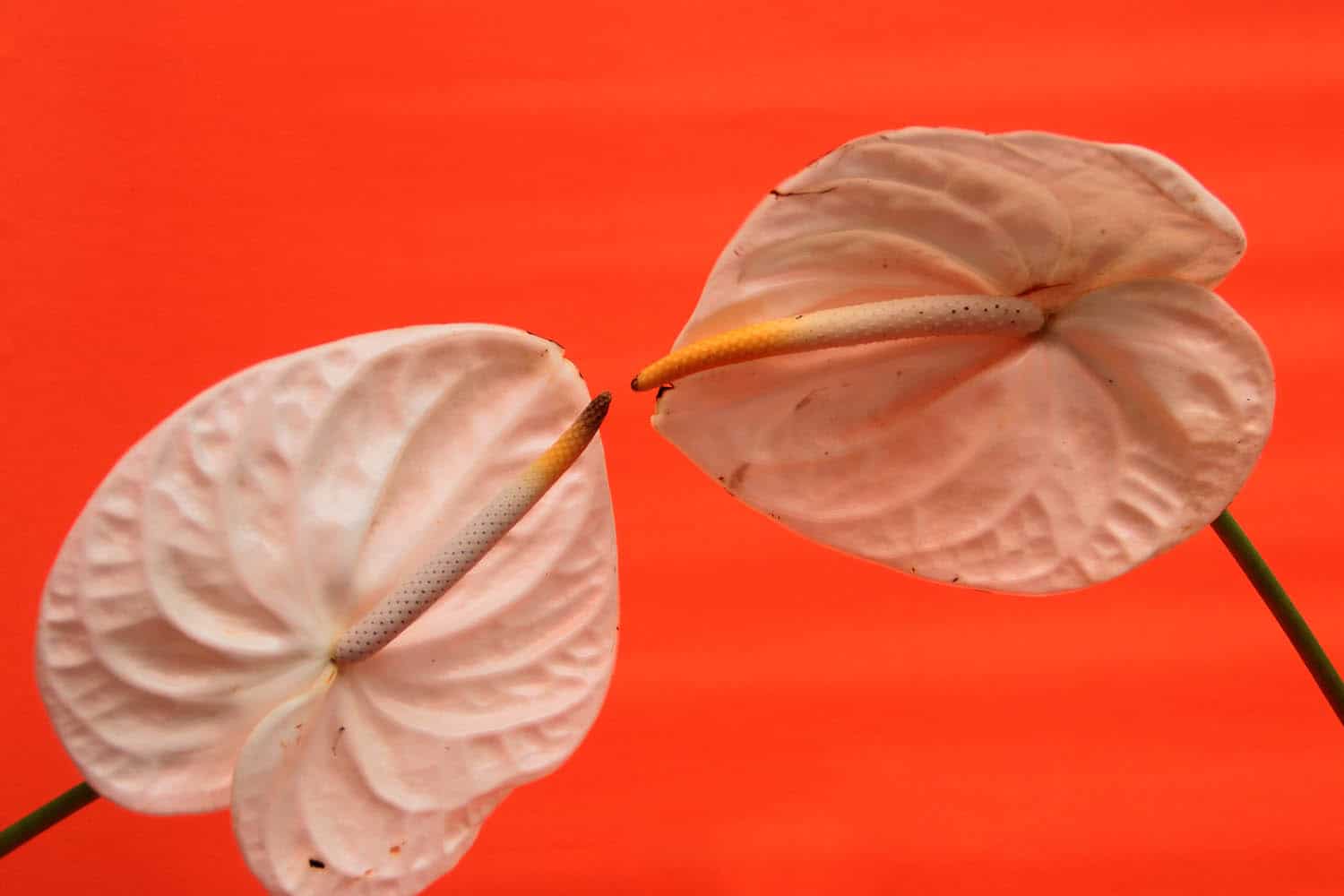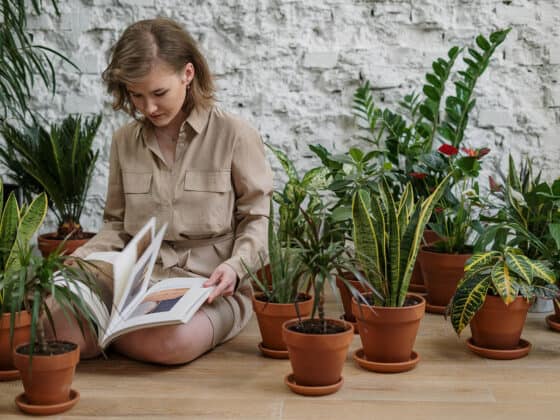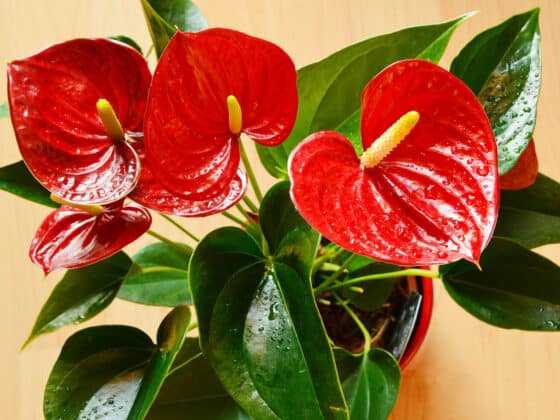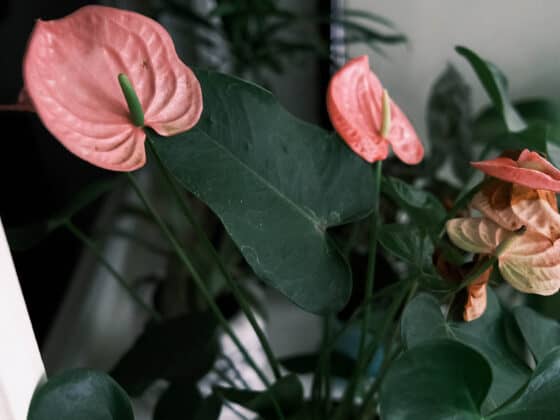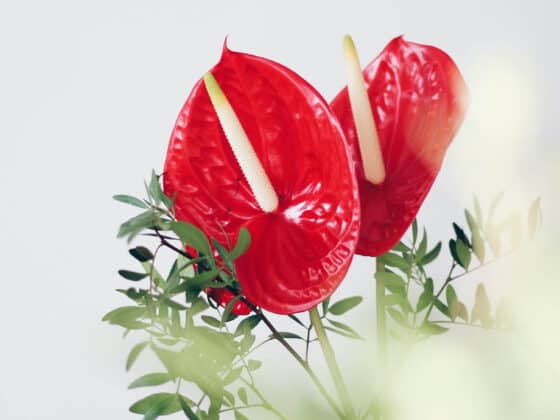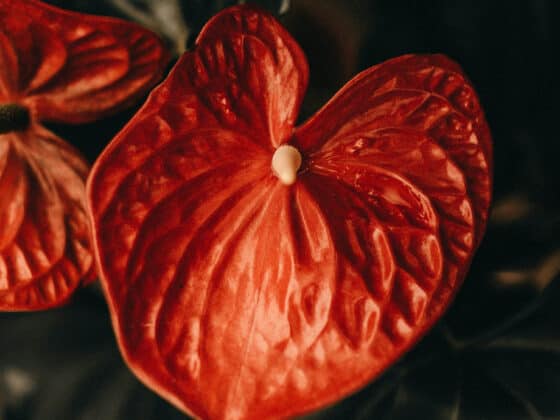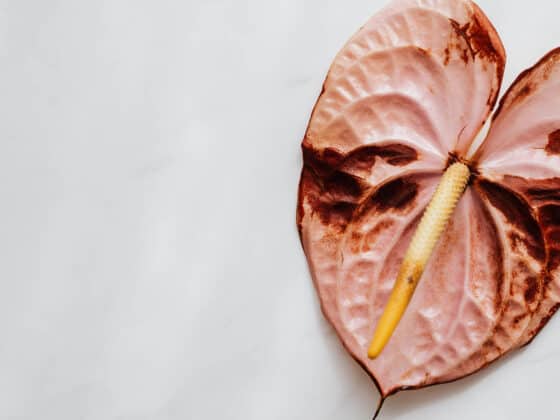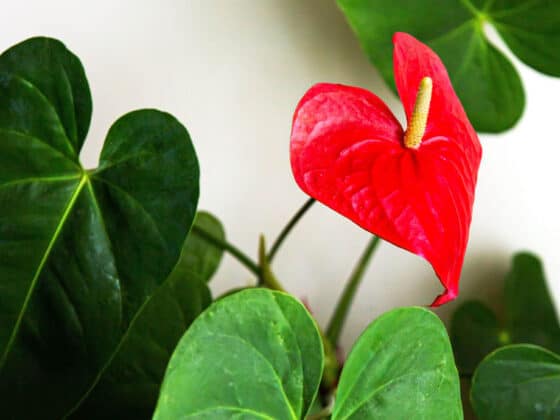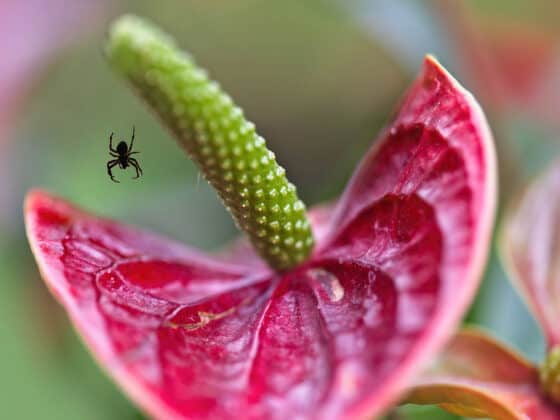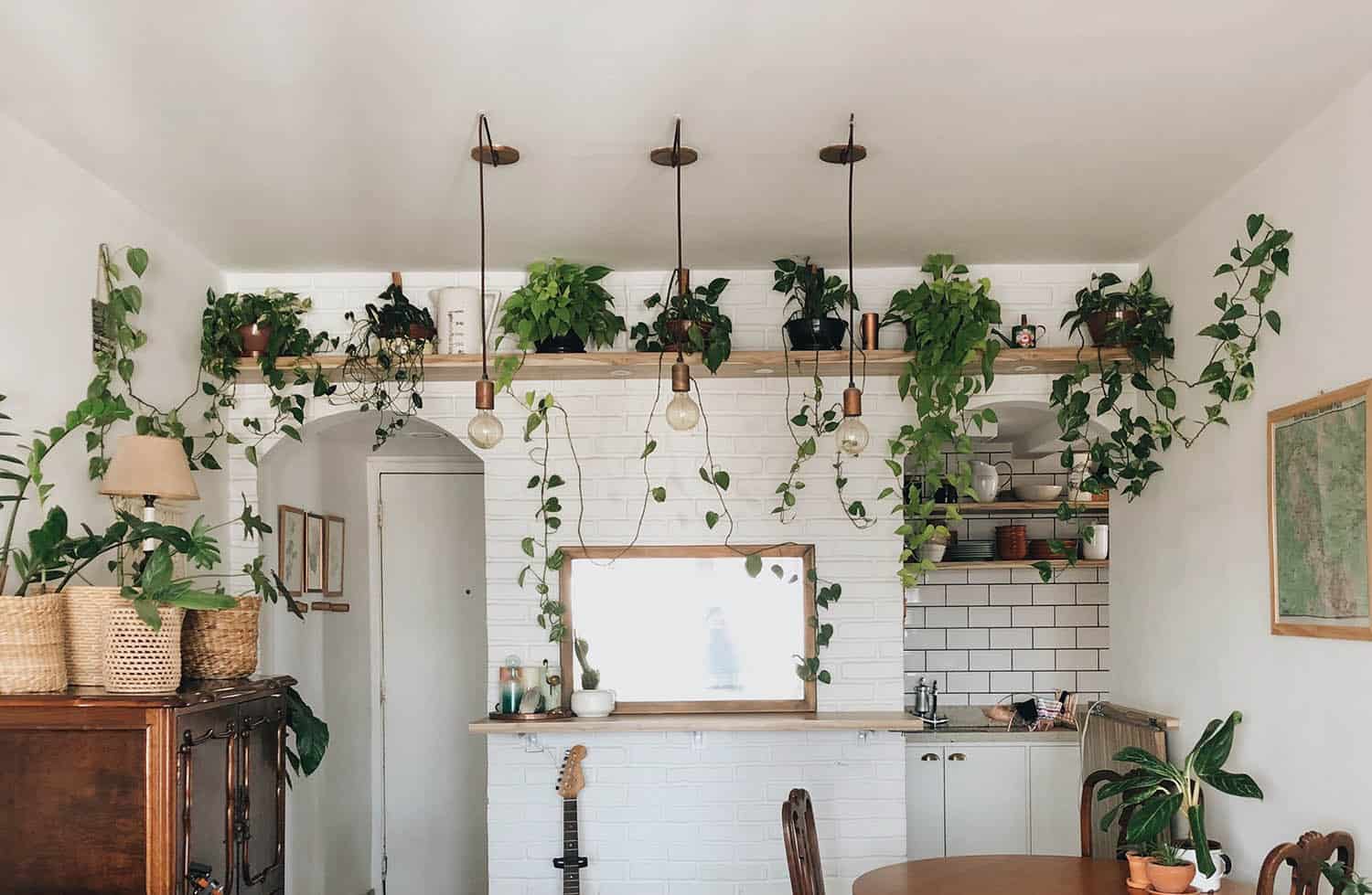When houseplant growers think of Anthuriums, they’re usually picturing a plant with blooms of shiny, vivid red. So you might be startled to find that yours is fading to green, white, or even brown. Fortunately, proper care will help you preserve the brilliant scarlet color of your Flamingo Flower.
Anthuriums will shift from red to green if they’re not getting enough light, so make sure yours receives plenty of illumination. If you bought your plant recently, it’s also possible that the greenhouse forced it to bloom too early, causing it to fade once you brought it home. In this case, it should return to normal in time.
Brown or faded flowers are often due to too much sun. Anthuriums prefer indirect light, so if yours is sitting right in a sunbeam, it can get burned and discolored. Brown spotting could also be a sign of a more severe issue like leaf blight or root rot.
How Long Do Anthurium Blooms Last?
Before you panic at the sight of fading flowers, remember it might just be part of the plant’s normal life cycle. Anthuriums can indeed flower all year round, but that doesn’t mean yours will have blooms every day of the year.
In good growing conditions, a healthy Anthurium will usually flower around every three months, with the blooms lasting for 2-3 months. Then it will need to rest for about the same length of time before blooming again.
The large, colorful, glossy portion of an Anthurium bloom is actually a modified leaf called the spathe. The true flowers are the tiny nubs covering the small protrusion – called a spadix – that grows from the middle of the spathe.
(Don’t worry if you find the terminology confusing. We do too! From here on out, when we say “flower,” you can assume we’re talking about the entire bloom, both spathe, and spadix.)
It’s normal for a spathe to show some fading in color as it ages. The overall hue will get duller and darker, and some green will start creeping in from the edges.
Even though this isn’t a sign of poor health, it’s a good idea to remove these fading blooms. That way, your plant won’t be expending energy to prop up dying spathes. Instead, it can concentrate on putting out fresh and colorful flowers.
On the other hand, if your Anthurium blooms have been around for less than two months and they’re already showing odd coloration, you may have a deeper issue on your hands. Let’s examine some of the other scenarios that can cause color change in Anthuriums.
Scenario 1: New Anthurium Turning Green
You’re wandering through your local gardening center when you spot it: a huge Anthurium with bright scarlet blooms. They seem to be calling out to you, like big shiny heart emojis. “I heart you too,” you whisper.
But the honeymoon phase doesn’t last long. Just a few days after you bring it home, you notice that the flowers are fading to a pale green. How did it all go so wrong?
It’s possible that your Anthurium’s glossy red flowers weren’t entirely natural. Commercial growers know that shoppers are more likely to buy a plant when it’s in bloom. So sometimes, they’ll use hormones to push an Anthurium to flower ahead of schedule.
Once it’s out of the greenhouse and no longer juicing, the plant returns to its ordinary growth cycle – and since it’s not supposed to be flowering yet, it begins to fade.
It’s understandable to be a little upset if this happens to you. But you can take some comfort in knowing that your Anthurium should produce bright red blooms again when the time is right. Sometimes true love requires patience.
Scenario 2: Anthurium Is Producing Green Flowers
On the other hand, if your plant’s blooms are coming in green and staying that way, it’s probably a sign that it’s not getting enough light.
Lighting conditions for these plants can be surprisingly tricky to balance. Many inexperienced houseplant owners, upon learning that Anthuriums don’t like direct light, treat them as shade plants.
But the Flamingo Flower evolved in the tropics, and it’s accustomed to receiving sun all day long. It just prefers its light filtered or reflected rather than beaming straight onto its leaves.
For the most vivid blooms, keep your Anthurium in a room that gets lots of natural light – just don’t position it right next to the window.
If you’re using fertilizer, there’s another possibility: your plant might be getting too much nitrogen. Anthuriums prefer a phosphorus-heavy diet, and an excess of nitrogen can also cause a color change.
Scenario 3: White Or Bleached Anthurium Blooms
What if, instead of turning green, your Anthuriums are getting washed out and pale? Here the culprit is usually temperature. Although Anthuriums are tropical plants, there is such a thing as too much heat, even for them!
Temperatures above 90 degrees Fahrenheit (roughly 32 degrees Celsius) can cause their colors to bleach. Just as you should keep your plant away from sunbeams, you should try not to position it right next to a radiator.
Direct sunlight can also fade an Anthurium’s colors even if the ambient temperature isn’t too hot.
Scenario 4: Brown Or Shriveled Anthurium Flowers
Green or white Anthurium flowers can still look quite pretty, even if they’re not the color you were hoping for. On the other hand, no one wants to see their blooms turning brown. If this is happening to you, there are a few possible causes.
First of all, your Anthurium might be suffering from nutrient deficiency. This is more common in older plants and may be accompanied by other symptoms, including drooping stems, fewer flowers, smaller flowers, reduced growth, or yellowing edges.
If this is the problem, you can supplement your Anthurium’s diet with a bit of fertilizer. We recommend the “weakly, weekly” method – fertilize once a week, with a high-phosphorus solution diluted to around 10-20% strength.
Another possible cause is leaf blight – a bacterial infection. Remember, although we’ve been referring to them as “flowers” for the sake of convenience, the red spathes on an Anthurium are actually leaves. And they’re susceptible to all the pathologies that can affect regular plant leaves.
In the case of an infection, the solution is simple: cut the infected tissue away. Snip off and dispose of every leaf that shows any sign of infection. Remember to disinfect your pruning shears between cuts to avoid spreading the bacteria to healthy portions of your Anthurium.
The last possibility is the most serious: brown and shriveled leaves can be an indicator of root rot. This is caused by overwatering. If the soil in your plant’s container is consistently soggy and damp, fungi and bacteria can run rampant and play havoc with its roots.
To avoid this issue, don’t water your Flamingo Flower on a fixed schedule – wait until the top portion of the soil has dried out before quenching its thirst again.
However, just changing up your watering habits won’t be enough if the rot has already set in. The only cure at that point is aggressive surgery. You’ll need to remove the plant from its container, trim away any and all rotten roots, and repot it.
Should Your Anthurium Flowers Actually Be Red?
There’s one other possibility you should consider: you didn’t have a red Anthurium in the first place.
While the most common varieties of Anthurium sold in the United States are those with bright red blooms, there are a huge number of other options. Even the popular Anthurium andreanum species encompasses a number of cultivars in hues ranging from orange to purple. Some interesting varieties are even designed to fade from one color to another or to sport two colors at once.
So before you start troubleshooting, you may want to check whether the flower you purchased is really supposed to be red!
What If You’re Not Getting Many Blooms At All?
If your Anthurium is putting out very little new growth and almost no new flowers, many of the same issues discussed above could be the culprit. Improper lighting, temperature, or watering habits can all affect an Anthurium’s ability to bloom.
If you have more questions surrounding why your plant is not blooming, read our article “10 Tips to Encourage Your Anthurium to Bloom and Flower.”
Final Thoughts
Anthuriums have a reputation as somewhat picky plants. The most crucial factors for ensuring brilliant blooms are proper lighting and temperature, but just about any problem with their growing conditions can interfere with flowering.
However, if you’re careful to give them the conditions they crave, Anthuriums will reward you with a gorgeous display that makes all the effort worth it.






